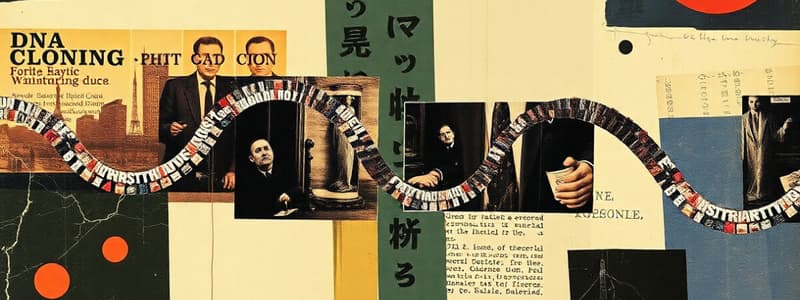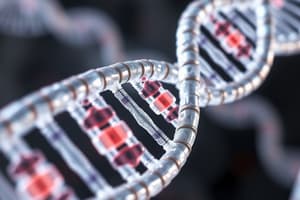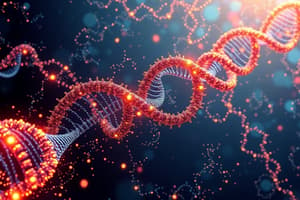Podcast
Questions and Answers
Which method involves the use of a high voltage pulse to introduce recombinant DNA into a host cell?
Which method involves the use of a high voltage pulse to introduce recombinant DNA into a host cell?
- Biolistics
- Electroporation (correct)
- Conjugation
- Heat shock method
What is the primary purpose of selectable markers in cloning vectors?
What is the primary purpose of selectable markers in cloning vectors?
- To allow identification of transformed cells (correct)
- To enhance gene expression
- To promote faster DNA replication
- To increase the size of the vector
What distinguishes a screenable marker from a selectable marker?
What distinguishes a screenable marker from a selectable marker?
- Selectable markers are always antibiotic resistance genes
- Screenable markers kill non-transformed cells
- Screenable markers require specific environmental conditions for expression
- Screenable markers produce a visible characteristic without harming cells (correct)
Which of the following is NOT a method of transformation?
Which of the following is NOT a method of transformation?
What happens to bacterial cells that contain a disrupted LacZ gene when grown on X-gal medium?
What happens to bacterial cells that contain a disrupted LacZ gene when grown on X-gal medium?
The blue-white selection technology is used to distinguish between which two types of colonies?
The blue-white selection technology is used to distinguish between which two types of colonies?
How do selectable markers function during the transformation process?
How do selectable markers function during the transformation process?
Contamination with undigested vector during cloning can lead to what issue?
Contamination with undigested vector during cloning can lead to what issue?
What color do bacteria harboring the pUC vector with insert DNA appear when grown in the presence of X-Gal?
What color do bacteria harboring the pUC vector with insert DNA appear when grown in the presence of X-Gal?
What is the product formed when β-galactosidase cleaves X-Gal?
What is the product formed when β-galactosidase cleaves X-Gal?
What is a common method to ensure that host cells contain the correct recombinant DNA?
What is a common method to ensure that host cells contain the correct recombinant DNA?
Which type of selection does the pUC vector use to differentiate between colonies?
Which type of selection does the pUC vector use to differentiate between colonies?
How is DNA separated to determine the size of fragments during gel electrophoresis?
How is DNA separated to determine the size of fragments during gel electrophoresis?
What is the role of IPTG in the context of the pUC vector?
What is the role of IPTG in the context of the pUC vector?
Which statement about the pUC vector is false?
Which statement about the pUC vector is false?
What type of gel is recommended for separating DNA fragments?
What type of gel is recommended for separating DNA fragments?
What is a key function of DNA ligases during the cloning process?
What is a key function of DNA ligases during the cloning process?
Which of the following statements is true regarding the use of a single restriction enzyme (RE)?
Which of the following statements is true regarding the use of a single restriction enzyme (RE)?
What is a limitation of using an RE that is present in the middle of the gene to be cloned?
What is a limitation of using an RE that is present in the middle of the gene to be cloned?
In the context of PCR, why is it important to create RE sites before ligation?
In the context of PCR, why is it important to create RE sites before ligation?
What is the function of sticky ends produced during cloning?
What is the function of sticky ends produced during cloning?
Why might a researcher choose to use a plasmid vector for cloning instead of chromosomal DNA?
Why might a researcher choose to use a plasmid vector for cloning instead of chromosomal DNA?
Which factor is NOT a consideration when selecting RE sites on the DNA to be cloned?
Which factor is NOT a consideration when selecting RE sites on the DNA to be cloned?
What is the expected result of using an RE that leads to concatemer formation?
What is the expected result of using an RE that leads to concatemer formation?
Flashcards
Blue-white screening
Blue-white screening
A method used to identify bacteria containing a recombinant plasmid vector with an inserted gene.
pUC vector
pUC vector
A plasmid vector commonly used in molecular cloning that contains a selectable marker and a reporter gene.
X-Gal
X-Gal
A substrate that produces a blue color when cleaved by β-galactosidase.
Recombinant plasmid
Recombinant plasmid
Signup and view all the flashcards
β-galactosidase
β-galactosidase
Signup and view all the flashcards
Agarose gel electrophoresis
Agarose gel electrophoresis
Signup and view all the flashcards
DNA marker
DNA marker
Signup and view all the flashcards
Antibiotic resistance
Antibiotic resistance
Signup and view all the flashcards
Recombinant DNA transformation
Recombinant DNA transformation
Signup and view all the flashcards
Transformation methods
Transformation methods
Signup and view all the flashcards
Selectable marker
Selectable marker
Signup and view all the flashcards
Selectable marker example
Selectable marker example
Signup and view all the flashcards
Screenable marker
Screenable marker
Signup and view all the flashcards
Screenable marker example
Screenable marker example
Signup and view all the flashcards
Blue-white selection
Blue-white selection
Signup and view all the flashcards
Problems during transformation
Problems during transformation
Signup and view all the flashcards
Multiple Cloning Site (MCS)
Multiple Cloning Site (MCS)
Signup and view all the flashcards
Restriction Enzymes (RE)
Restriction Enzymes (RE)
Signup and view all the flashcards
DNA Ligation
DNA Ligation
Signup and view all the flashcards
Self-ligation
Self-ligation
Signup and view all the flashcards
Concatemer
Concatemer
Signup and view all the flashcards
PCR for sticky ends
PCR for sticky ends
Signup and view all the flashcards
Sub-cloning
Sub-cloning
Signup and view all the flashcards
Why choose PCR for sticky ends?
Why choose PCR for sticky ends?
Signup and view all the flashcards
Study Notes
DNA Engineering and Cloning
- Lecture Objectives: Learn about restriction enzymes, cloning DNA fragments in plasmids, transforming recombinant plasmids into bacterial cells, and different bacterial and eukaryotic vectors.
- Text Section: 7.1.20.1.
- Additional Reading: Material available on Canvas.
Cloning DNA/Gene
- Clone: An identical copy of a single mother cell.
- DNA/Gene Cloning Process:
- Separates a specific gene or DNA fragment from a larger DNA molecule (e.g., chromosome).
- Inserts the specific fragment into a vector (plasmid or carrier DNA).
- Introduces the "construct" into a host cell.
- Replicates the DNA in the host cell.
Restriction Endonucleases (REs)
- RE Function: Recognize and cut DNA at specific nucleotide sequences.
- RE Types:
- Type I: Cuts DNA at a random site far from the recognition site (hundreds of bases). Recognition site is asymmetrical, with 3-4 nucleotides in one section and 4-5 nucleotides in another.
- Type II: Cuts DNA within the recognition site. Recognition site is palindromic and 4-8 nucleotides long. Commonly used in DNA work.
- Type III: Cuts DNA about 20-30 base pairs after the recognition site. Recognizes two inversely oriented non-palindromic sequences.
- Sticky Ends: Produced by some REs and can base-pair with each other or with complementary sticky ends.
- Blunt Ends: Produced by other REs.
- Base Cutters: Most frequently used REs in molecular biology are 6 base cutters.
Frequency of Type II RE Cutting
- Cutting Frequency Calculation: Y = 4n, where Y = expected number of cuts and n = number of bases in the recognition site.
- 6 bp cutter: Cuts once every 46 (4,096) base pairs, on average.
- 4 bp cutter: Cuts once every 44 (256) base pairs, on average.
Cloning DNA/Gene Steps
- 1. Select a vector (Fig 7-4).
- 2. Select appropriate restriction enzymes (REs) for the target gene and vector.
- 3. Digest the vector and target gene with the appropriate REs.
- 4. Ligate the target gene to the vector.
- 5. Transform the recombinant DNA into bacteria.
- 6. Select transformed bacteria.
- 7. Ensure host cells carry the recombinant DNA.
Cloning Vectors
- Purpose: DNA "vehicles" capable of self-replication, used for cloning, maintaining, and delivering DNA to biological systems.
- Types: Modified versions of naturally occurring plasmids (small DNA molecules in bacteria) or small viral DNA.
- Key Features:
- Origin of replication (ori)
- Selectable marker (e.g., TetR or AmpR)
- Screenable marker (e.g., GFP and LacZ)
- Multiple Cloning Site (MCS)
- Relatively small size
Vector Classes
- i) Housekeeping: pBR322, pUC18/19 etc.
- ii) Expression: pET and pGEX vectors.
- iii) Delivery (Transformation): pCAMBIA (for plant transformation).
pUC19 Vector
- Ideal for: Gene cloning and maintenance.
Selecting RE Sites on DNA
- a) Locating Existing Sites: Software is available online (e.g., http://molbiol-tools.ca/) to find RE sites in a DNA sequence.
- b) Creating New Sites: PCR can be used (strategy 2).
Digesting DNA with REs
- REs cut at specific sequences, creating either sticky or blunt ends.
Ligation
- DNA ligases join DNA ends (strand breaks or nicks).
- The 5' terminus must be phosphorylated.
- The 3' terminus must have a free OH group.
Concatemer Concerns
- If only one RE is used, the target DNA may form a concatemer. This can create issues.
Transforming DNA into a Host Organism
- Methods: Heat shock, electroporation, conjugation, biolistics (gene gun).
Identifying Transformed Host Cells
- Selectable Markers: Genes (e.g., antibiotic resistance) that allow growth of cells under specific conditions (transformation).
- Common Antibiotics: Ampicillin, kanamycin, and tetracycline.
- Screenable Markers: To visually identify cells and easier to select transformed colonies.
- Example: LacZ gene.
Creating Sticky Ends via PCR
- Designed PCR primers
- Amplify the target gene in two separate reactions
- Purify/clean PCR products
- Mix products equally
- Denature and re-nature to generate desired sticky ends
Studying That Suits You
Use AI to generate personalized quizzes and flashcards to suit your learning preferences.




